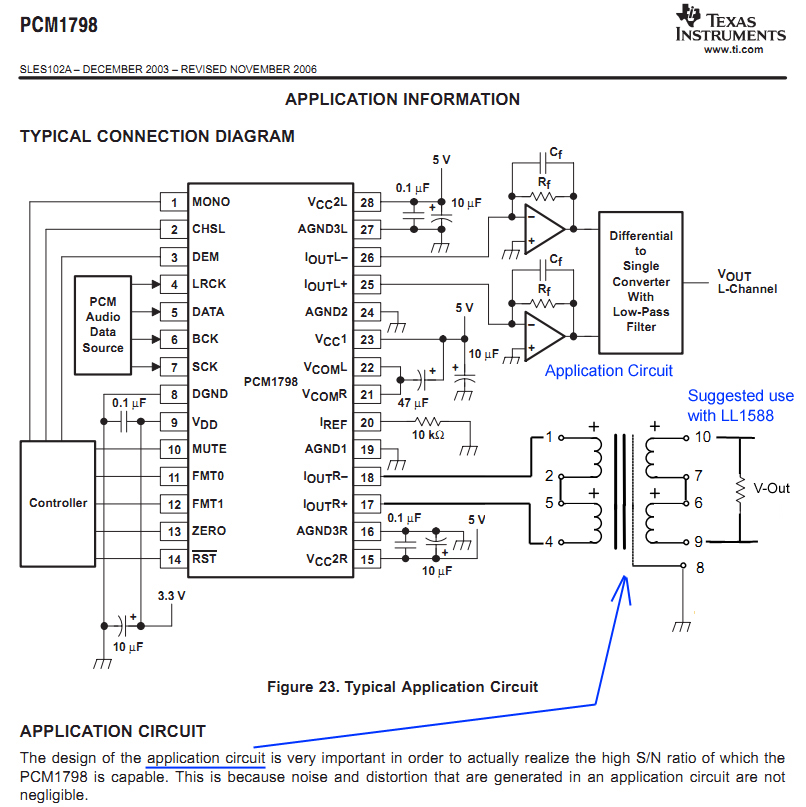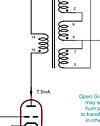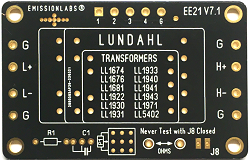Signal Output transformers
Description
An output transformer can have several functions, such as:
- DAC Output
- Break the ground loop (Solve hum problems
- Pre-amplifier Output
- Provide electrical safety (Headphone)
- Options available
DAC Output
This is a wonderful application for a transformer. The quality of almost any DAC System will be improved. Popular DAC IC's have a differential current output. As you can see in the next picture. To this output, additional electronic circuitry has to be connected to perform the symmetric to asymmetric conversion, and also high frequency noise and quantisation noise had to be removed. This requires analog solid state circuits at a relative sensitive position, with the problems related to this. These functions can nicely be performed by a transformer all at once, and additionally we get an galvanic decoupling of the output. So any ground loops is present now, or by surprise at a later moment, will not occur.

The recommended transformer, first must be able to withstand a small DC offset from offset error of the DAC during normal operation. Second, it must be able to withstand any undefined condition of the outputs for whatever the reason. For instance, what happens at a repeated power on/off, or when the supply voltage drops, or has spikes. Such undefined condition may have a larger DC components for a short moment. Yet, this will damage most Push Pull output transformers by permanent magnetizing of the core. For the same reason, it is not allowed to test such transformer windings with an ohms meter, as these by default pump 1mA DC current into an unknown resistor. This will leave a permanent magnetic field in the transformer, and from then on, it will have distortion. However a DAC can unintentionally cause the same. For this reason a transformer type must be used with a core of mu-metall. This is a special alloy, with lowest remanence (remaining field) of all known magnetics. The transformer type for DAC outputs is LL1588. This is a universal transformer, bit it is extremely well suited for DAC. There is no reason to take another type, but in case you do, it is needed to use a mu-metall type.
LL1684 which is the amorphous core version of LL1588 can NOT be used for the same reason, because amorphous core miniature transformers will not forgive any accidental DC voltage.
Achievements of DAC transformer are:
1.Elimination of DC offset.
2.Break the ground loop at the output, by creating a floating output.
3.Filter out the natural quantization noise, and some high frequency disturbance from the DAC converter IC
Application hint:
The transformer will only do a current to voltage conversion when loaded with a resistor at the secondary side.
Break the ground loop.
The transformer data sheets may show application hints with or without ground loop, because that is by itself not a function of the datasheet, to teach how to do this.
For a symmetric output it is assumed it is clear how to use this.
For an asymmetric output, so normal RCA output, it is possible to ignore the whole ground loop issue, and do as if this does not exist. That will work most of the time, but there can be situations now or later, with unexpected hum, and nobody understands the reason. So you will end up in reversing mains plugs, or change the position of the pre amp. Yet if there is a current loop constructed in the hearing room, one way or another, if something induces some small current into it, the result will be hum. Current loops are like one single winding. Only not the winding of a transformer, but rather one huge air coil winding laying free in the room. The winding is made of the sound cable, the mains cable, the ground path, anything. As soon as you have a closed loop, it may pick up hum.
The way to break the ground loop, is by isolating the "ground" output of the transformer from the chassis. For this, use an isolated ground RCA plug, and connect it to the (isolated) ground of that RCA connector. If done right, logically, there will be no connection any more from the tone cable ground to the chassis ground. The ground loop is now "broken" at this point. Meaning, no hum current can flow any more (in a circle) through the loop.
Pre-amplifier Output
Either use for this the larger transformers, which can be Single Ended or Push Pull. For pre amplifiers, there is now also the EE21 board. Technically speaking, this board is not very difficult, but most of all it ensures correct connections, and fast configuration, with switchable gain
These are step down transformers, because a tube is a device with medium or high impedance and medium gain. What we need at the output is normally not a high voltage signal, but a low impedance signal. Note, you step down the impedance with the square of the step down ratio.
The output impedance really gets very low, when you use a tube with good gain, and medium impedance. Such medium impedance tubes have often very good linearity. As an example, use for instance the NOS 7N7 it is low cost, and easy to use. It even has a metal shielded base, which you can ground to the amplifier chassis. If you parallel the two systems in one tube, gain will stay the same. DC current will double from 9 to 18mA , and output impedance goes down from 7770 to 3850 Ohms. Drive a 9:1 step down with this tube, will give an effective gain of 2x and an output impedance of 20x20 lower, so you get an amazingly low 9.6 Ohms at the output. Such a pre amp can drive any amplifier, virtually hum free, be it an 600 Ohms or a high impedance (47k) type. Interconnection cables can be simply twisted, like with silver wire, self-made.
Many other examples are possible of course, and you will see, there is a Lundahl for almost every tube. Select the tube for good linearity, because you will have some reasonable output signal, peak to peak. Such tubes have medium gain, like from 10...40. Do not tale more gain than you need, because lower gain tubes have lower plate impedance, and that is always helpful to get the best out of a transformer. When you found one, you will soon see, many tube can be used beautifully. Indeed this is an ideal application for signal transformers.
LL1692A (3.5:1)
LL1660 (4.5:1)
LL2745 (6:1)
LL1689 (9:1)
LL1680 (9:1 or 18:1)

Application Circuits
used 18:1 here, with C3g and 6SN7
Options available:
Transformer Cap |
Cap #2. Made of thick iron, for magnetic shielding. |
S |
With a static shield, between the input and output, avoiding unwanted signals to go INTO the pre amplifier via the output cables. |
AM |
Amorphous core |
SE |
Single Ended. |
PP |
Push Pull |
PPZ |
Push Pull Zero. For Parafeed. (This is a Single Ended output with Anode Choke, and capacitor coupled output transformer). Must be high voltage foil caps, like Mundorf Silver Oil, or others. |
Ag |
Silver wound version. Sorry price is high, because pure silver content is a lot. |
Combined |
Options like S, Ag, and AM can be combined with any other. Example: LL1660-S-AM-PP-Ag |
